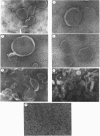Abstract
The structural transition stages induced by the interaction of the non-ionic surfactant Triton X-100 on phosphatidylcholine unilamellar vesicles were studied by means of static and dynamic light-scattering, transmission-electron-microscopy (t.e.m.) and permeability changes. A linear correlation was observed between the effective surfactant/lipid molar ratios (Re) ('three-stage' model proposed for the vesicle solubilization) and the surfactant concentration throughout the process. However, this correlation was not noted for the partition coefficients of the surfactant between the bilayer and the aqueous medium (K). Thus a sharp initial K increase was observed until a maximum value was achieved for permeability alterations of 50% (initial step of bilayer saturation). Further surfactant additions resulted in a fall in the K values until 100% of bilayer permeability. Additional amounts of surfactant led to an increase in K until bilayer solubilization. Hence, a preferential incorporation of surfactant molecules into liposomes governs the initial interaction steps, leading to the initial stage of bilayer saturation with a free surfactant concentration that was lower than its critical micelle concentration (c.m.c.). Additional amounts of surfactant increased the free surfactant until the c.m.c. was reached, after which solubilization started to occur. Thus the initial step of bilayer saturation was achieved for a smaller surfactant concentration than that for the Resat, although this concentration was the minimum needed for solubilization to start. Large unilamellar vesicles began to form as the surfactant exceeded 15 mol% (50% bilayer permeability), the maximum vesicle growth being attained for 22 mol% (400 nm). Thereafter, static light-scattering started to decrease gradually, this fall being more pronounced after 40 mol%. The t.e.m. picture for 40 mol% (Resat.) showed unilamellar vesicles, although with traces of smaller structures. From 50 mol% the size distribution curves began to show a bimodal distribution. The t.e.m. pictures for 50-64 mol% revealed tubular structures, together with open bilayer fragments. Thereafter, increasing amounts of surfactant (65-69 mol%) led to planar multilayered structures which gradually tended to form concentric and helicoidal conformations. The scattered intensity decreased to a low constant value at more than 71-72 mol%. However, the surfactant concentration for the Re(sol) (72.6 mol %) still presented traces of aggregated structures, albeit with mono-modal size-distribution curves (particle size of 50 nm). This vesicle size corresponded to the liposome solubilization via mixed-micelle formation.
Full text
PDF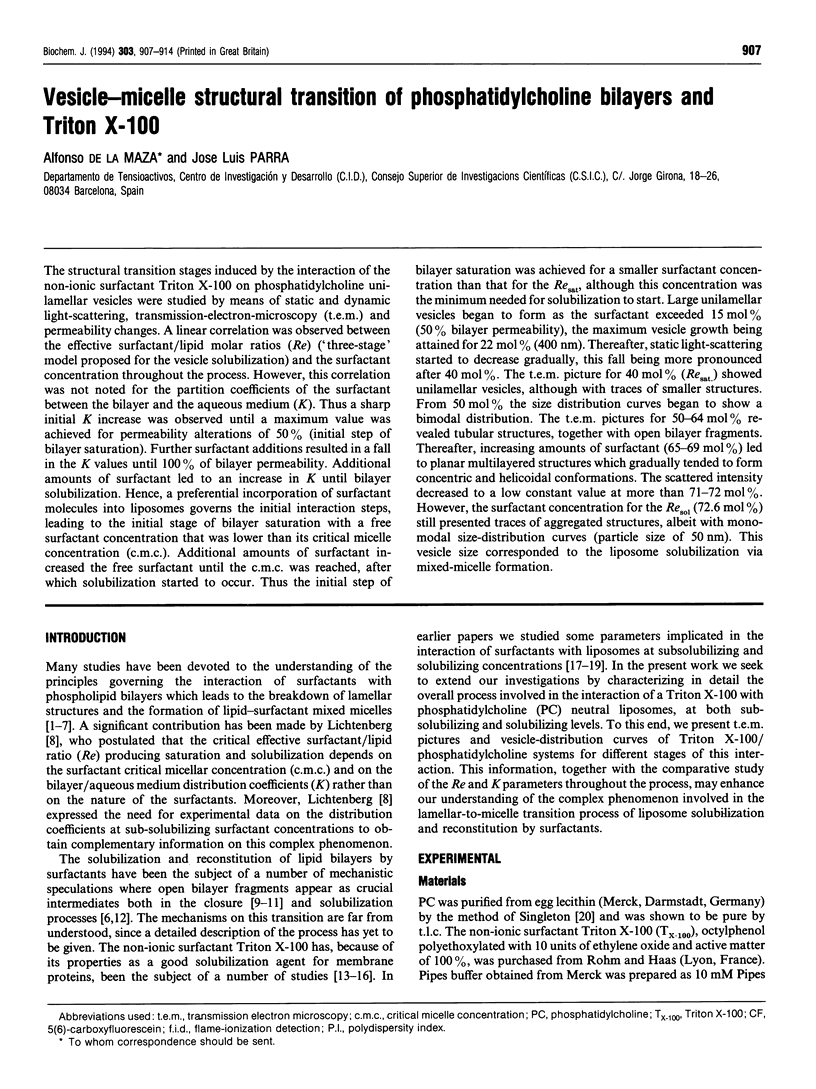
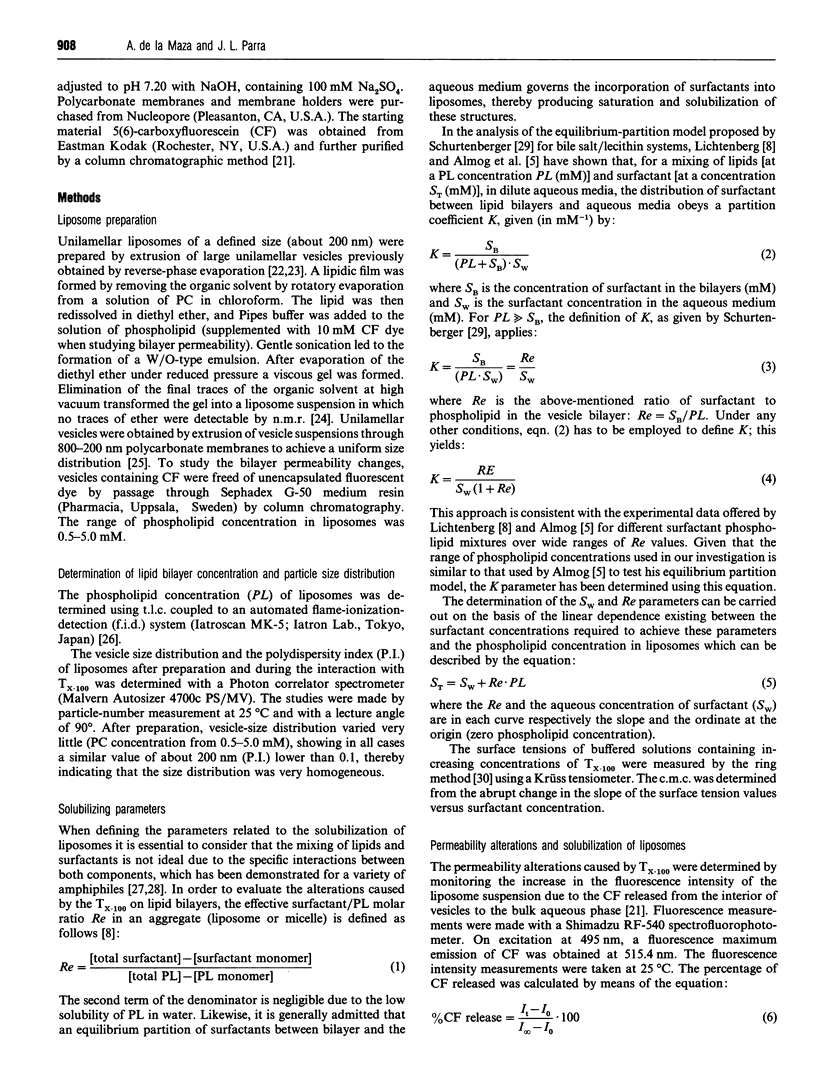
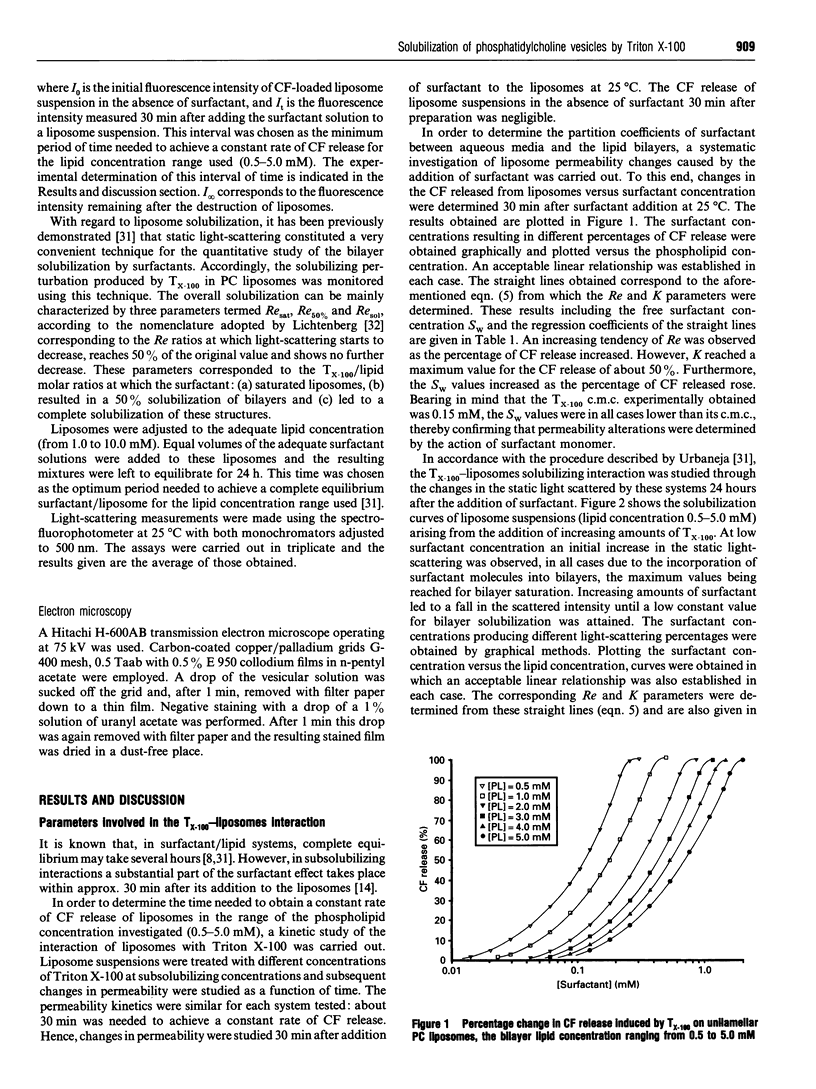
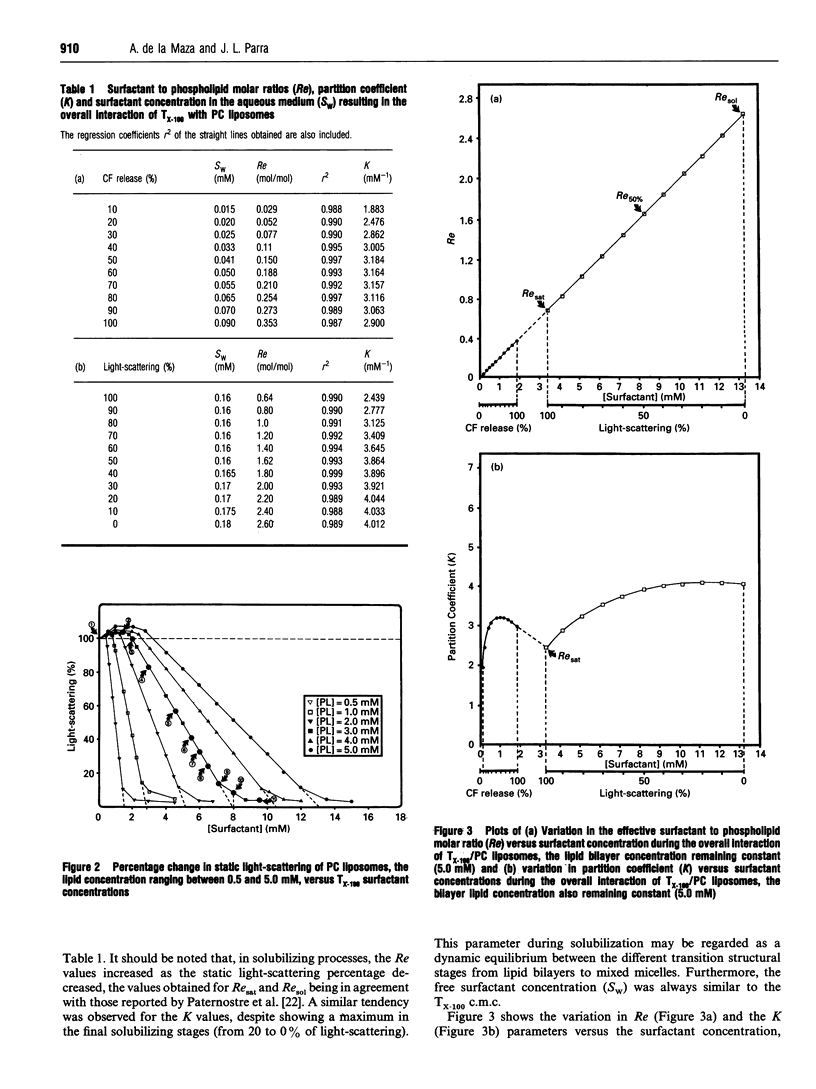
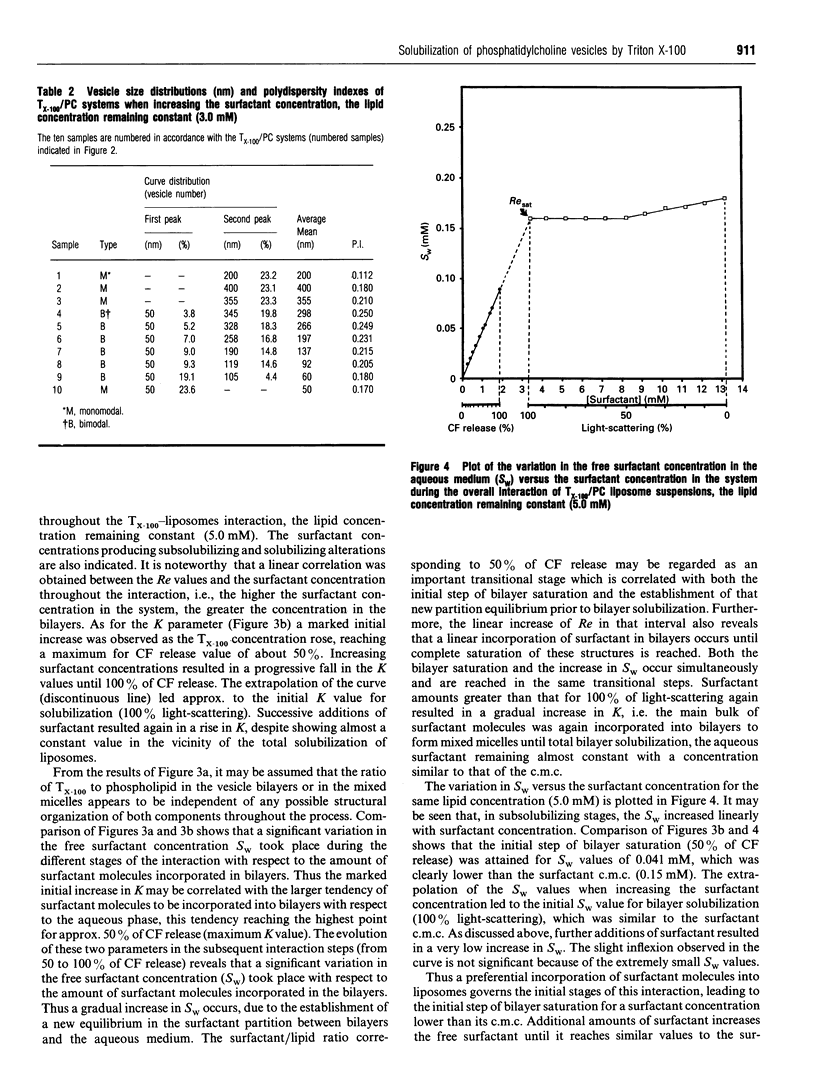
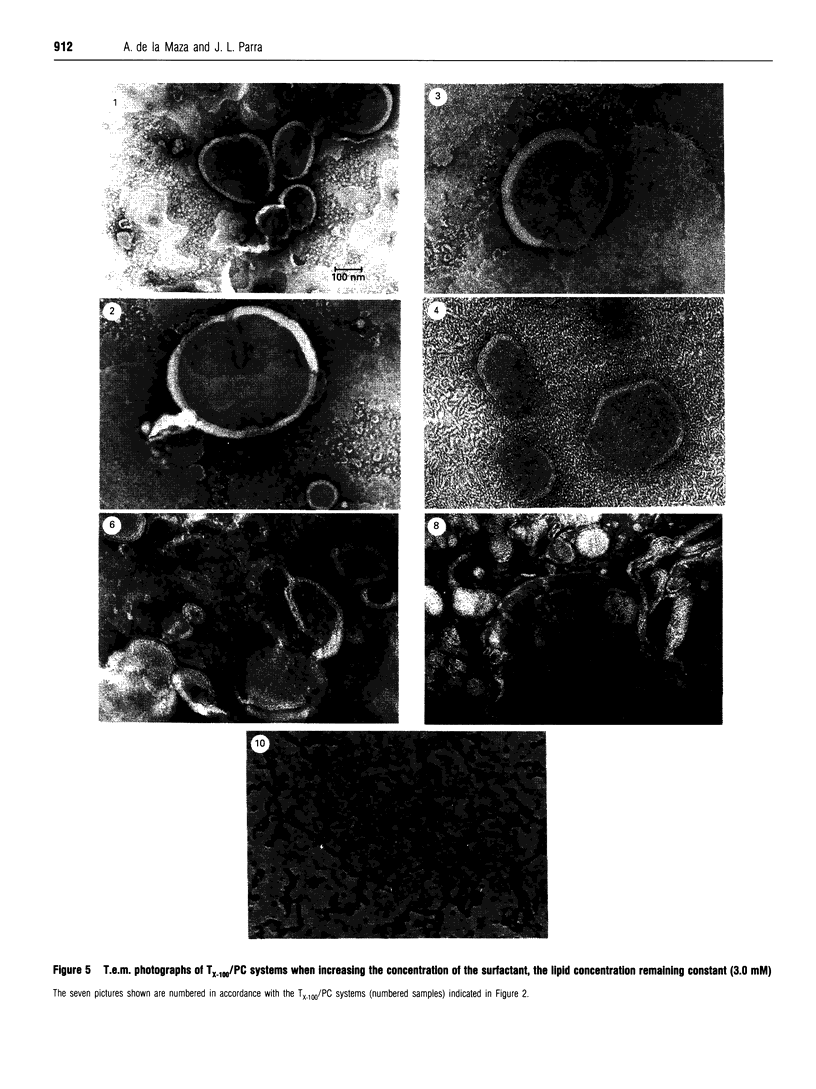
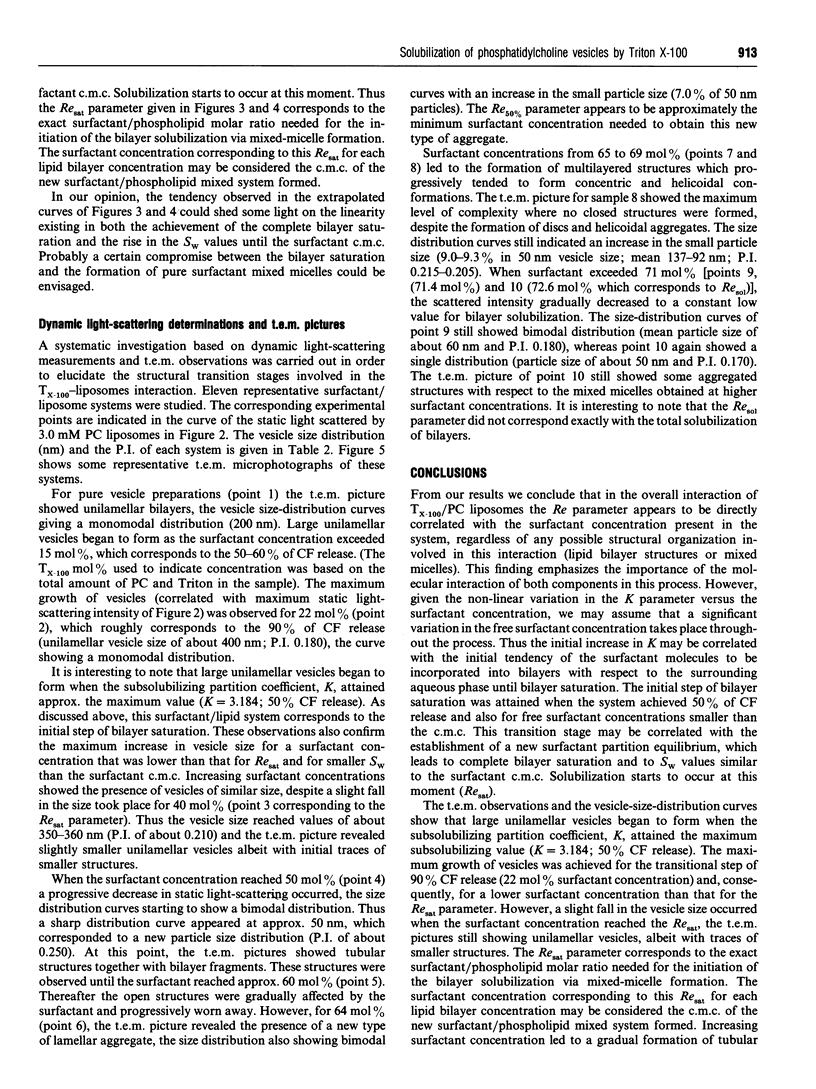
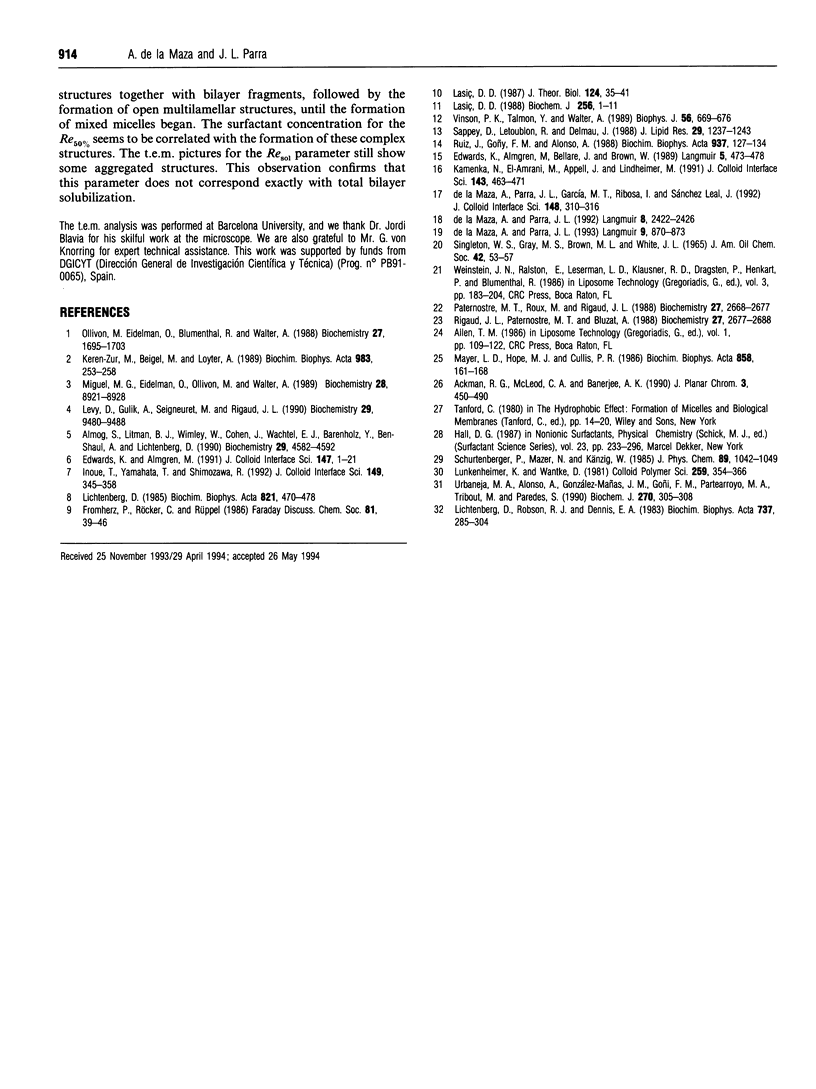
Images in this article
Selected References
These references are in PubMed. This may not be the complete list of references from this article.
- Almog S., Litman B. J., Wimley W., Cohen J., Wachtel E. J., Barenholz Y., Ben-Shaul A., Lichtenberg D. States of aggregation and phase transformations in mixtures of phosphatidylcholine and octyl glucoside. Biochemistry. 1990 May 15;29(19):4582–4592. doi: 10.1021/bi00471a012. [DOI] [PubMed] [Google Scholar]
- Christie J. D., Rakusan T. A., Martinez M. A., Lucia H. L., Rajaraman S., Edwards S. B., Hayden C. K., Jr Hydranencephaly caused by congenital infection with herpes simplex virus. Pediatr Infect Dis. 1986 Jul-Aug;5(4):473–478. doi: 10.1097/00006454-198607000-00020. [DOI] [PubMed] [Google Scholar]
- Keren-Zur M., Beigel M., Loyter A. Induction of fusion in aggregated and nonaggregated liposomes bearing cationic detergents. Biochim Biophys Acta. 1989 Aug 7;983(2):253–258. doi: 10.1016/0005-2736(89)90241-1. [DOI] [PubMed] [Google Scholar]
- Levy D., Gulik A., Seigneuret M., Rigaud J. L. Phospholipid vesicle solubilization and reconstitution by detergents. Symmetrical analysis of the two processes using octaethylene glycol mono-n-dodecyl ether. Biochemistry. 1990 Oct 9;29(40):9480–9488. doi: 10.1021/bi00492a022. [DOI] [PubMed] [Google Scholar]
- Lichtenberg D. Characterization of the solubilization of lipid bilayers by surfactants. Biochim Biophys Acta. 1985 Dec 19;821(3):470–478. doi: 10.1016/0005-2736(85)90052-5. [DOI] [PubMed] [Google Scholar]
- Lichtenberg D., Robson R. J., Dennis E. A. Solubilization of phospholipids by detergents. Structural and kinetic aspects. Biochim Biophys Acta. 1983 May 24;737(2):285–304. doi: 10.1016/0304-4157(83)90004-7. [DOI] [PubMed] [Google Scholar]
- Marinier D. S., Letoublon R., Delmau J. Phosphorus NMR analysis of human white matter in mixed non-ionic detergent micelles. J Lipid Res. 1988 Sep;29(9):1237–1243. [PubMed] [Google Scholar]
- Mayer L. D., Hope M. J., Cullis P. R. Vesicles of variable sizes produced by a rapid extrusion procedure. Biochim Biophys Acta. 1986 Jun 13;858(1):161–168. doi: 10.1016/0005-2736(86)90302-0. [DOI] [PubMed] [Google Scholar]
- Ollivon M., Eidelman O., Blumenthal R., Walter A. Micelle-vesicle transition of egg phosphatidylcholine and octyl glucoside. Biochemistry. 1988 Mar 8;27(5):1695–1703. doi: 10.1021/bi00405a047. [DOI] [PubMed] [Google Scholar]
- Paternostre M. T., Roux M., Rigaud J. L. Mechanisms of membrane protein insertion into liposomes during reconstitution procedures involving the use of detergents. 1. Solubilization of large unilamellar liposomes (prepared by reverse-phase evaporation) by triton X-100, octyl glucoside, and sodium cholate. Biochemistry. 1988 Apr 19;27(8):2668–2677. doi: 10.1021/bi00408a006. [DOI] [PubMed] [Google Scholar]
- Rigaud J. L., Paternostre M. T., Bluzat A. Mechanisms of membrane protein insertion into liposomes during reconstitution procedures involving the use of detergents. 2. Incorporation of the light-driven proton pump bacteriorhodopsin. Biochemistry. 1988 Apr 19;27(8):2677–2688. doi: 10.1021/bi00408a007. [DOI] [PubMed] [Google Scholar]
- Ruiz J., Goñi F. M., Alonso A. Surfactant-induced release of liposomal contents. A survey of methods and results. Biochim Biophys Acta. 1988 Jan 13;937(1):127–134. doi: 10.1016/0005-2736(88)90234-9. [DOI] [PubMed] [Google Scholar]
- SINGLETON W. S., GRAY M. S., BROWN M. L., WHITE J. L. CHROMATOGRAPHICALLY HOMOGENEOUS LECITHIN FROM EGG PHOSPHOLIPIDS. J Am Oil Chem Soc. 1965 Jan;42:53–56. doi: 10.1007/BF02558256. [DOI] [PubMed] [Google Scholar]
- Urbaneja M. A., Alonso A., Gonzalez-Mañas J. M., Goñi F. M., Partearroyo M. A., Tribout M., Paredes S. Detergent solubilization of phospholipid vesicle. Effect of electric charge. Biochem J. 1990 Sep 1;270(2):305–308. doi: 10.1042/bj2700305. [DOI] [PMC free article] [PubMed] [Google Scholar]
- Vinson P. K., Talmon Y., Walter A. Vesicle-micelle transition of phosphatidylcholine and octyl glucoside elucidated by cryo-transmission electron microscopy. Biophys J. 1989 Oct;56(4):669–681. doi: 10.1016/S0006-3495(89)82714-6. [DOI] [PMC free article] [PubMed] [Google Scholar]
- da Graça Miguel M., Eidelman O., Ollivon M., Walter A. Temperature dependence of the vesicle-micelle transition of egg phosphatidylcholine and octyl glucoside. Biochemistry. 1989 Oct 31;28(22):8921–8928. doi: 10.1021/bi00448a035. [DOI] [PubMed] [Google Scholar]



